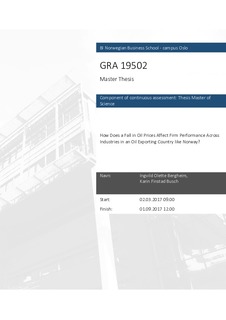How does a fall in oil prices affect firm performance across industries in an oil exporting country like Norway?
Master thesis
Permanent lenke
http://hdl.handle.net/11250/2479447Utgivelsesdato
2017Metadata
Vis full innførselSamlinger
- Master of Science [1621]
Sammendrag
The purpose of this thesis is to get insight into how the Norwegian economy is
affected by changes in oil prices, with emphasis on the 2014 oil bust. We also study
if this effect differs between Norwegian industries. We use data from all registered
Norwegian firms in the period from 2000 to 2015.
We investigate how oil price changes affect the Norwegian economy, measured
through firms’ return on assets and return on equity, by using panel data regression
analysis. We perform the same regression on all industries in Norway and
investigate if industries’ exposure to the oil price determines how they are affected
by fluctuations in oil prices. We also include an analysis of bankruptcies in Norway
during the period from 2000 to 2016 to further explore how changes in oil prices
affect different industries. Finally, we investigate if negative shocks have a bigger
impact on Norwegian industries than positive shocks, as proposed by the prospect
theory.
Testing 41 396 Norwegian companies we find that the Norwegian firm
performance, as a whole, will be affected by a fall in oil price. The coefficient for
oil price changes is positive, which means that firm performance, collectively,
decreases when the oil price decreases. For the Norwegian industries with a
statistical significant relationship between percentage change in oil price and return
on assets, the oil price coefficient is positive for every industry, except two. We
find that for most industries consuming oil, the economic activity plays a
determinant role along with the actual price of oil. When it comes to the number of
bankruptcies in Norway during our sample period, we find evidence that
bankruptcies tend to move in the opposite direction of the oil price. From our last
analysis we find asymmetry in response to different oil price shocks. We find that
a negative event has a statistically significant effect, and that a positive event is not
statistically different than zero.
Beskrivelse
Masteroppgave(MSc) in Master of Science in Business, Business law, tax and accounting - Handelshøyskolen BI, 2017
